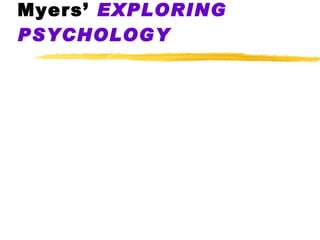Learning
•Download as PPT, PDF•
8 likes•2,753 views
1. Observational learning, also known as social learning or modeling, occurs when behavior changes as a result of observing others. 2. Albert Bandura's social learning theory emphasized that observational learning can occur without direct reinforcement or punishment - by observing models and the consequences of their behavior, people can learn new behaviors. 3. Observational learning involves four processes: attention, retention, motor reproduction, and motivation. By observing models, consequences, and one's own abilities, people determine which behaviors to adopt and perform.
Report
Share
Report
Share

Recommended
More Related Content
What's hot
What's hot (20)
Similar to Learning
Similar to Learning (20)
Recently uploaded
Mehran University Newsletter is a Quarterly Publication from Public Relations OfficeMehran University Newsletter Vol-X, Issue-I, 2024

Mehran University Newsletter Vol-X, Issue-I, 2024Mehran University of Engineering & Technology, Jamshoro
Recently uploaded (20)
This PowerPoint helps students to consider the concept of infinity.

This PowerPoint helps students to consider the concept of infinity.
Unit-V; Pricing (Pharma Marketing Management).pptx

Unit-V; Pricing (Pharma Marketing Management).pptx
Role Of Transgenic Animal In Target Validation-1.pptx

Role Of Transgenic Animal In Target Validation-1.pptx
Mixin Classes in Odoo 17 How to Extend Models Using Mixin Classes

Mixin Classes in Odoo 17 How to Extend Models Using Mixin Classes
Asian American Pacific Islander Month DDSD 2024.pptx

Asian American Pacific Islander Month DDSD 2024.pptx
Energy Resources. ( B. Pharmacy, 1st Year, Sem-II) Natural Resources

Energy Resources. ( B. Pharmacy, 1st Year, Sem-II) Natural Resources
On National Teacher Day, meet the 2024-25 Kenan Fellows

On National Teacher Day, meet the 2024-25 Kenan Fellows
Z Score,T Score, Percential Rank and Box Plot Graph

Z Score,T Score, Percential Rank and Box Plot Graph
ICT role in 21st century education and it's challenges.

ICT role in 21st century education and it's challenges.
Learning
- 1. Myers’ EXPLORING PSYCHOLOGY
- 14. Pavlov’s Classic Experiment Before Conditioning During Conditioning After Conditioning UCS (food in mouth) Neutral stimulus (tone) No salivation UCR (salivation) Neutral stimulus (tone) UCS (food in mouth) UCR (salivation) CS (tone) CR (salivation)
- 16. Classical Conditioning UCS (passionate kiss) UCR (sexual arousal) CS (onion breath) CS (onion breath) CR (sexual arousal) UCS (passionate Kiss) UCR (sexual arousal)
- 18. Classical Conditioning Strength of CR Pause Acquisition (CS+UCS) Extinction (CS alone) Extinction (CS alone) Spontaneous recovery of CR
- 23. Nausea Conditioning in Cancer Patients UCS (drug) UCR (nausea) CS (waiting room) CS (waiting room) CR (nausea) UCS (drug) UCR (nausea)
- 42. Schedules of Reinforcement Variable Interval Number of responses 1000 750 500 250 0 10 20 30 40 50 60 70 Time (minutes) Fixed Ratio Variable Ratio Fixed Interval Steady responding Rapid responding near time for reinforcement 80
- 45. Punishment
- 54. Operant vs. Classical Conditioning
- 69. (Presence of reinforcement or punishment)
- 70. Reinforcement theory of motivation was proposed by BF Skinner and his associates. It states that individual’s behavior is a function of its consequences. (based on law of effect)
- 72. - Anything that increase the behavior - is a consequence of behavior that decreases the likelihood of repetition.
- 75. Television and Observational Learning
Editor's Notes
- Preview Question 4: Do cognitive processes and biological constraints affect classical conditioning?
- Preview Question 5: Why is Pavlov’s work important?
- Preview Question 7: What are the basic types of reinforcers?
- Preview Question 11: How might educators, business managers, and other individuals apply operant conditioning?
- Preview Question 12: What is observational learning?
